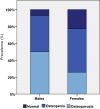Characteristics of adults with down syndrome: prevalence of age-related conditions
- PMID: 25593924
- PMCID: PMC4292207
- DOI: 10.3389/fmed.2014.00051
Characteristics of adults with down syndrome: prevalence of age-related conditions
Abstract
Introduction: In the last decades, life expectancy of persons with Down syndrome (DS) has dramatically increased and it is estimated that they will be living as long as the general population within a generation. Despite being included among the progeroid syndromes, because of the presence of features typically observed in older adults, DS is still regarded as a disease of pediatric interest. Because limited knowledge is available on the clinical characteristics of adults with DS, this study aimed to assess clinical and non-clinical features of this population and to describe similarities to the geriatric population.
Methods: In this study, we described 60 adults with DS evaluated at the Day Hospital of the Geriatric Department of the Policlinico A. Gemelli, Università Cattolica del Sacro Cuore in Rome. Individuals were assessed through a standardized protocol.
Results: The mean age of study participants was 38 years (range, 18-58 years) and 42 (70.0%) were women. Geriatric conditions were highly prevalent: severe cognitive impairment was diagnosed in 39 (65.0%) participants, behavioral symptoms were present in 25 (41.7%), and functional impairment in 23 (38.3%). Six (10.0%) participants lived in institutions and 11 (18.3%) were diagnosed as obese. The mean number of drugs used was 2.4; use of psychotropic drugs was highly prevalent. The most common chronic diseases were thyroid problems (44, 73.3%), followed by mood disorders (19, 31.7%), osteoporosis (18, 30.0%), and cardiac problems (10, 16.7%). Geriatric conditions and chronic diseases were more prevalent among participants aged ≥40 years.
Conclusion: Several similarities between older adults and adults with DS were observed. Comorbidities, geriatric conditions, cognitive and functional deficits, and social problems are highly prevalent in both populations, contributing to the high complexity of these patients' assessment and treatment.
Keywords: Down syndrome; aging; geriatric assessment; geriatric syndromes; multimorbidity; premature.
Figures
References
-
- Centers for Disease Control and Prevention (CDC). Racial disparities in median age at death of persons with Down syndrome – United States, 1968-1997. MMWR Morb Mortal Wkly Rep (2001) 50:463–5. - PubMed
LinkOut - more resources
Full Text Sources
Other Literature Sources



